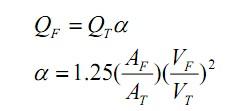|
著作权归作者所有。 商业转载请联系作者获得授权,非商业转载请注明出处。 作者:小刀 链接:http://zhuanlan.zhihu.com/xiaodao/20284502 来源:知乎 Dear sirs: Good day! Recently IACS released this new UI SC246 for “steering gear test with the vessel not at the deepest seagoing draught (or rudder not fully submerged)”, it introduces a formula for the use of the predication/extrapolation of steering performance from the trial condition to the deepest seagoing condition.   PF is the estimated steering actuator hydraulic pressure in the deepest seagoing draught condition PT is the maximum measured actuator hydraulic pressure in the trial condition. Basically, from this Formula we could learn that: 1. Steering Gear Hydraulic Pressure - Psg is in linear relation with the rudder wet area and quadratic of ship's speed. 2. If the estimated steering actuator hydraulic pressure at the deepest draught is less than the specified maximum working pressure of the rudder actuator, it can be deemed satisfied. Here we had a case, which to be run with above formula and finally lead to a dramatic result. =============================================================== Particulars of ship: Ship Type: 64K Bulk Carrier Rudder: single typical Type-D rudder and single propeller Steering Gear: RR rotary-vane S/G which is driven by two(2) fixed-displacement pumps (Gear pump). Max allowed oil pressure: 170 bar Max output Torque: 1065 KN.m Sea Trial max oil pressure: 150 bar by two pumps operating. Performance Time of steering 30/35 degrees: approx. 12.5 sec ============================================================= During the Sea Trials, we carried out the steering test at different ship speeds and drafts respectively, here the result is: Steering Performance in different ship speeds
at ballast condition (Aft Draft: 7.7 m) Steering Performance in different ship drafts at 14 knts
Remark: 1. Ship’s designed service speed is 14.4 knts. 2. Aft draft at heavy ballast condition is 9.2m, and rudder’s height is also 9.2m, considering the trim in sea trial, there would be a very small part of rudder exposing to the air (almost equivalent to “fully-submerged”) 3. Rudder’s entire area Af= 39.0 m2 and wet area in trial At= 34.0 m2 @7.7m draft. It looks we don’t need to do any extrapolation if rudder is fully submerged in the sea trial. YES, but this is the second vessel of a series, and the No.1 vessel was just tested in ballast condition, the extrapolation calculation result with this UI proposed formula was really beyond our imagination , thus we decided to organize this entire test at different speeds and drafts on No.2 vessel to see if the UI formula is accurate or not . A simple Math quiz: PF= PT *1.25 * Af/At=140*1.25*39/34=200.7 bar which is much higher than the S/G max working pressure (170 bar). In case of this, the formula is unavailable to be used for proving that the SOLAS required steering time (<28s) is predictably met with. Once we approach to the S/G maker –RR, they replied: our S/G is equipped with fixed displacement pumps, that is to say, the flow of hydraulic oil is constant, and we know that the total capacity of hydraulic oil to be injected into chamber is also fixed, then the time would be fixed as well. From the sea trial records, we could see that the steering time would basically remain the same no matter how draft or speed changes. This is only one ship type’s trial data which is much deviated from the derived formula, it cannot prove the incorrectness of that Formula, and here it is just reported to your kind team only for a further refining work. Some comments/findings are raised here as well. 1. When we take a look back to the derivation progress of this formula, the most doubtful part is that : The steering gear torque is linear with oil pressure--Yes The rudder moment is linear with rudder area --Yes But the steering gear driven torque is not naturally and linearly related with rudder torque (moment), --No (* here I noticed the word “assumed”) Thus to link the S/G oil pressure to rudder wet area linearly seems not so reliable. 2. From our case, the oil pressure seems not a linear to ship speed quadratic but ship speed, but this is just a guess as one ship data is not sufficient. 3. From our case, the S/G oil pressure seems roughly linear relation with ship’s speed, which shows that the ship’s speed performs much more effect on rudder than rudder area does, but it still needs further confirmation. 4. We also study the UI SC246 relevant technical background materials, it summarised that this proposed Formula is not fully demonstrated with sufficient validated trial records. Thus more cases should be collected to refine or revise the prediction method/formula. Hope this case would provide some useful information for your kind team and also looking forward to your great ideas and comments. Your replies would be highly appreciated and thanks! Best Regards! |

"谈古今,论船舶,小刀有话说."本期刀仔收集整理了一些关于船 ...[详细]
曾经在一次同事聚会上耳听得一个小笑话,某验船师G曾收到D船厂的约检单,说了过两 ...[详细]
船舶在海上遇险后,首要任务就是向外发送求救信号.很多人可能第一反应就是打手机啊 ...[详细]

"谈古今,论船舶,小刀有话说."分段检查内功心法口诀准备工作 ...[详细]

"谈古今,论船舶,小刀有话说."(一)“Nonono,reject,absolut ...[详细]
前面的一篇介绍了船舶上的无线电设备,其实在无线电检验中还包含了一些非SOLAS_Ch ...[详细]
西洋有英人劳氏,双百年前,于咖啡馆内,创”劳埃德”。自此,遂世有船级社之名。 ...[详细]
著作权归作者所有。商业转载请联系作者获得授权,非商业转载请注明出处。作者:小 ...[详细]

作者:刀仔来源:微信公众号xiaodaomarine"谈古今,论船舶,小刀 ...[详细]

CradletoGraveShips,thehumanmadegiantwhales船舶,人工制造的巨 ...[详细]